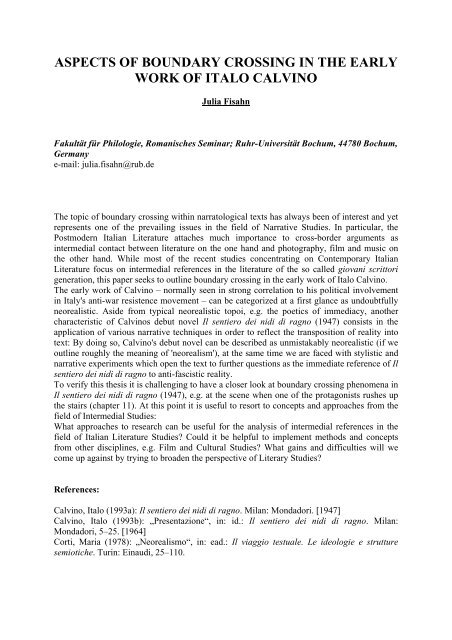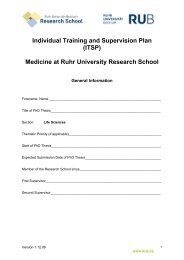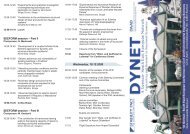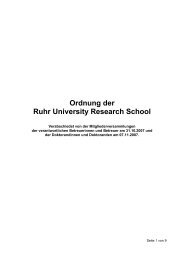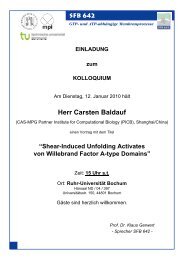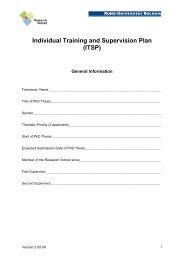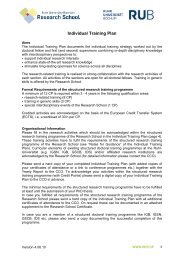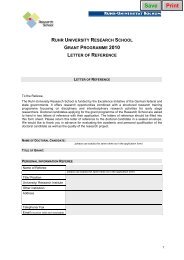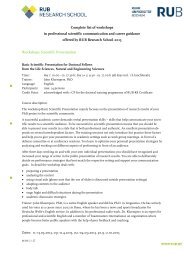Section Days abstract book 2010.indd - RUB Research School ...
Section Days abstract book 2010.indd - RUB Research School ...
Section Days abstract book 2010.indd - RUB Research School ...
Create successful ePaper yourself
Turn your PDF publications into a flip-book with our unique Google optimized e-Paper software.
ASPECTS OF BOUNDARY CROSSING IN THE EARLY<br />
WORK OF ITALO CALVINO<br />
Julia Fisahn<br />
Fakultät für Philologie, Romanisches Seminar; Ruhr-Universität Bochum, 44780 Bochum,<br />
Germany<br />
e-mail: julia.fisahn@rub.de<br />
The topic of boundary crossing within narratological texts has always been of interest and yet<br />
represents one of the prevailing issues in the field of Narrative Studies. In particular, the<br />
Postmodern Italian Literature attaches much importance to cross-border arguments as<br />
intermedial contact between literature on the one hand and photography, film and music on<br />
the other hand. While most of the recent studies concentrating on Contemporary Italian<br />
Literature focus on intermedial references in the literature of the so called giovani scrittori<br />
generation, this paper seeks to outline boundary crossing in the early work of Italo Calvino.<br />
The early work of Calvino – normally seen in strong correlation to his political involvement<br />
in Italy's anti-war resistence movement – can be categorized at a first glance as undoubtfully<br />
neorealistic. Aside from typical neorealistic topoi, e.g. the poetics of immediacy, another<br />
characteristic of Calvinos debut novel Il sentiero dei nidi di ragno (1947) consists in the<br />
application of various narrative techniques in order to reflect the transposition of reality into<br />
text: By doing so, Calvino's debut novel can be described as unmistakably neorealistic (if we<br />
outline roughly the meaning of 'neorealism'), at the same time we are faced with stylistic and<br />
narrative experiments which open the text to further questions as the immediate reference of Il<br />
sentiero dei nidi di ragno to anti-fascistic reality.<br />
To verify this thesis it is challenging to have a closer look at boundary crossing phenomena in<br />
Il sentiero dei nidi di ragno (1947), e.g. at the scene when one of the protagonists rushes up<br />
the stairs (chapter 11). At this point it is useful to resort to concepts and approaches from the<br />
field of Intermedial Studies:<br />
What approaches to research can be useful for the analysis of intermedial references in the<br />
field of Italian Literature Studies? Could it be helpful to implement methods and concepts<br />
from other disciplines, e.g. Film and Cultural Studies? What gains and difficulties will we<br />
come up against by trying to broaden the perspective of Literary Studies?<br />
References:<br />
Calvino, Italo (1993a): Il sentiero dei nidi di ragno. Milan: Mondadori. [1947]<br />
Calvino, Italo (1993b): „Presentazione“, in: id.: Il sentiero dei nidi di ragno. Milan:<br />
Mondadori, 5–25. [1964]<br />
Corti, Maria (1978): „Neorealismo“, in: ead.: Il viaggio testuale. Le ideologie e strutture<br />
semiotiche. Turin: Einaudi, 25–110.


